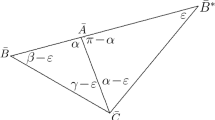Abstract
As is well-known, numerical experiments show that Napoleon’s Theorem for planar triangles does not extend to a similar statement for triangles on the unit sphere \(S^2\). Spherical triangles for which an extension of Napoleon’s Theorem holds are called Napoleonic, and until now the only known examples have been equilateral. In this paper we determine all Napoleonic spherical triangles, including a class corresponding to points on a 2-dimensional ellipsoid, whose Napoleonisations are all congruent. Other new classes of examples are also found, according to different versions of Napoleon’s Theorem for the sphere. The classification follows from successive simplifications of a complicated original algebraic condition, exploiting geometric symmetries and algebraic factorisations.







Similar content being viewed by others
Notes
The condition \(\langle P_{i+1}P_{i+2}\rangle \geqslant -1/2\) is needed to ensure that there exist equilateral spherical triangles \(Q_iP_{i+1}P_{i+2}\), and \(\langle P_{i+1},P_{i+2}\rangle \not = -1/2\) ensures that the interiors of the equilateral triangles are well-defined (otherwise \(Q_i,P_{i+1},P_{i+2}\) would be cogeodesic).
The conditions \(d_i\in (0,\sqrt{3})\) must still be satisfied.
When \(\langle P_0,P_1\rangle =-1/2\) the equilateral spherical triangle \(P_0P_1Q_2\) is the great circle through \(P_0,P_1\).
Because of these choices, if \(\langle P_2,P_0\rangle =\langle P_1,P_0\rangle \) then \(\langle R_2,R_0\rangle =\langle R_1,R_0\rangle \). Similarly, if \(\langle P_0,P_1\rangle =\langle P_2,P_1\rangle \) then \(\langle R_0,R_1\rangle =\langle R_2,R_1\rangle \), and if \(\langle P_1,P_2\rangle =\langle P_0,P_2\rangle \) then \(\langle R_1,R_2\rangle =\langle R_0,R_2\rangle \). At this stage however, our attention is not limited to the case where \(P_0P_1P_2\) is isosceles.
Indeed, one can suppose that a rewarding strategy in signal transmission consists in “covering the largest possible surface with the least possible mutual distances among the antennas”: the formulation of this isoperimetric problem in the class of triangular patterns of antennas is optimised by equilateral configurations (in turn, the isoperimetric problem for triangles can be explicitly solved, for example, by writing the area of a general triangle using Heron’s formula and using the AM-GM inequality to see that the optimiser is equilateral; another proof can be performed by purely geometrical arguments by considering an ellipse with foci centred at two vertices and passing through the third one).
References
Abrikosov, A.A.: On the magnetic properties of superconductors of the second group. Sov. Phys. JETP 5, 1174 (1957)
Ben-Joseph, E., Gordon, D.: Hexagonal planning in theory and practice. J. Urban Design 5(3), 237–265 (2000)
Bennemann, K.H., Ketterson, J.B.: Novel Superfluids, vol. 1. Oxford University Press, Oxford (2013)
Bourgain, J.: New encounters in combinatorial number theory: from the Kakeya problem to cryptography. In: Benedicks, M., Jones, P.W., Smirnov, S., Winckler, B. (eds.) Perspectives in Analysis Mathematical Physics Studies, vol. 27, pp. 17–26. Springer, Berlin (2005)
Chang, A., Csörnyei, M.: The Kakeya needle problem and the existence of Besicovitch and Nikodym sets for rectifiable sets. Proc. Lond. Math. Soc. (3) 118(5), 1084–1114 (2019). https://doi.org/10.1112/plms.12207
Correggi, M., Pinsker, F., Rougerie, N., Yngvason, J.: Vortex phases of rotating superfluids. J. Phys.: Conf. Ser. 414, 1–7 (2013)
Courty, A., Henry, A.-I., Goubet, N., Pileni, M.-P.: Large triangular single crystals formed by mild annealing of self-organized silver nanocrystals. Nat. Mat. 6, 900–907 (2007). https://doi.org/10.1038/nmat2004
Deer, W.A., Howie, R.A., Zussman, J.: Rock-Forming Minerals. Orthosilicates, vol. 1. Geological Society, London (1997)
Douglas, J.: On linear polygon transformations. Bull. Am. Math. Soc. 46, 551–560 (1940). https://doi.org/10.1090/S0002-9904-1940-07259-3. (MR21788)
Eddleston, M.D., Hejczyk, K.E., Cassidy, A.M.C., Thompson, H.P.G., Day, G.M., Jones, W.: Highly unusual triangular crystals of theophylline: the influence of solvent on the growth rates of polar crystal faces. Cryst. Growth Des. 15, 2514–2523 (2015). https://doi.org/10.1021/acs.cgd.5b00295
Gardner, M.: The Unexpected Hanging and Other Mathematical Diversions: A Classic Collection of Puzzles and Games from Scientific American. American Mathematical Society, Providence (2020)
Grünbaum, B.: Is Napoleon’s theorem really Napoleon’s theorem? Am. Math. Mon. 119(6), 495–501 (2012). https://doi.org/10.4169/amer.math.monthly.119.06.495. (MR2928662)
Hajja, M., Martini, H., Spirova, M.: New extensions of Napoleon’s theorem to higher dimensions. Beiträge Algebra Geom. 49(1), 253–264 (2008). (MR2410581)
Kleiner, W.H., Roth, L.M., Autler, S.H.: Bulk solution of Ginzburg-Landau equations for type II superconductors: Upper critical field region. Phys. Rev. II. Ser. 133A, a1226–a1227 (1964)
Kurowski, P.M.: Finite Element Analysis for Design Engineers. Warrendale, SAE International (2016)
MacKenzie, W.S., Guilford, C.: Atlas of Rock-Forming Minerals in Thin Section. Ad Wes Lon Higher, London (1980)
McCartin, B.J.: Mysteries of the Equilateral Triangle. Hikari Ltd., Rousse (2010)
McKay, A.: An analogue of Napoleon’s theorem in the hyperbolic plane. Can. Math. Bull. 44(3), 292–297 (2001). https://doi.org/10.4153/CMB-2001-029-3. (MR1847491)
Nahin, P.J.: When Least is Best. How Mathematicians Discovered Many Clever Ways to Make Things as Small (or as Large) as Possible. Princeton University Press, Princeton, NJ (2004)
Neumann, B.H.: Some remarks on polygons. J. Lond. Math. Soc. 16, 230–245 (1941). https://doi.org/10.1112/jlms/s1-16.4.230. (MR68399)
Pauling, L.: The principles determining the structure of complex ionic crystals. J. Am. Chem. Soc. 51, 1010–1026 (1929). https://doi.org/10.1021/ja01379a006
Peitgen, H.-O., Jürgens, H., Saupe, D.: Chaos and Fractals. New Frontiers of Science. Springer, New York (1992)
Petr, K.: Ein Satz über Vielecke. Arch. Math. Phys. (3) 13, 29–31 (1908)
Petrenko, V.F., Whitworth, R.W.: Physics of Ice. Oxford University Press, Oxford (2002)
Sabonnadière, J.-C., Coulomb, J.-L.: Finite Element Methods in CAD. Electrical and Magnetic Fields. Springer, New York (2013)
Scriba, C.J.: Wie kommt “Napoleons Satz" zu seinem Namen? Historia Math. 8(4), 458–459 (1981). https://doi.org/10.1016/0315-0860(81)90054-9. (German)
Shephard, G.C.: Another generalisation of Napoleon’s theorem. Elem. Math. 64(4), 137–145 (2009). https://doi.org/10.4171/EM/126. (MR2558297)
Treuden, M.R.: Napoleon-like properties of spherical triangles. In: Electr. Proc. 8th Intern. Conf. Techn. Colleg. Math., Addison-Wesley, 1–5 (1995)
Van Aubel, H.: Note concernant les centres de carrés construits sur les côtés d’un polygon quelconque. Nouv. Corresp. Math. 4, 40–44 (1878)
Viglione, R.: 103.25 An extension of Thébault’s second problem. Math. Gaz. 103(557), 343–346 (2019). https://doi.org/10.1017/mag.2019.72
West, A.R.: Solid State Chemistry and Its Applications. Wiley, Chichester (2014)
Author information
Authors and Affiliations
Corresponding author
Additional information
Publisher's Note
Springer Nature remains neutral with regard to jurisdictional claims in published maps and institutional affiliations.
About this article
Cite this article
Dipierro, S., Noakes, L. & Valdinoci, E. Napoleonic Triangles on the Sphere. Bull Braz Math Soc, New Series 55, 19 (2024). https://doi.org/10.1007/s00574-024-00393-9
Received:
Accepted:
Published:
DOI: https://doi.org/10.1007/s00574-024-00393-9



